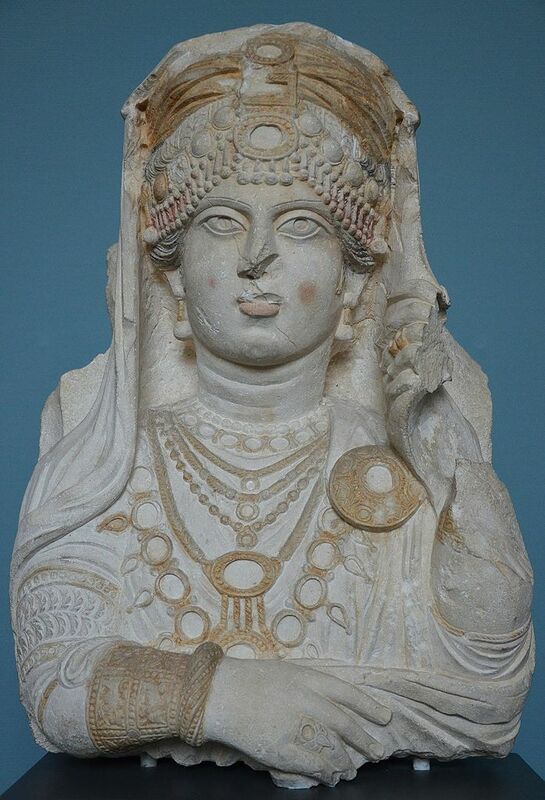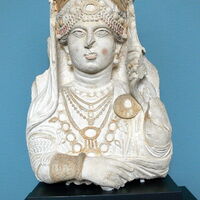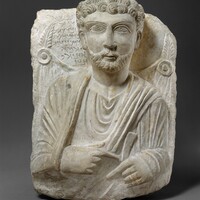Funerary busts from Palmyra
Type:
Grave markers
Date:
Second to third century CE
Location or Findspot (Modern-Day Country):
Syria
Dimensions:
"Beauty of Palmyra": 55 × 40 × 18 cm
Zabda'ateh: 52 × 38 × 19 cm
Description:
The wealthy oasis of Palmyra (Syria) was situated along the major trade routes between the Roman and Parthian Persian empires. In the first centuries CE the city had hundreds of communal tomb towers. Inside each one were multiple niches for bodies, each closed with a limestone slab that depicted bust- or half-length images of the deceased, alone or in family groups. Over 3,000 of these idealized "portraits" survive, more than from anywhere else in the ancient world except Rome. They reveal stylistic and sartorial inspiration from both Roman and Iranian arts and were originally brightly polychromed. About one-third of the surviving funerary busts depict women.
The woman shown here, known as the "Beauty of Palmyra" (ca. 190–210), is one of the most richly garbed of all the reliefs. The sculpture displays her wealth and status in the form of jewelry that was originally covered with gold leaf and inlaid with colored glass; the eyes were inlaid as well, increasing the sense of vitality. The quantity of jewelry is associated with a late date; earlier images communicate their status in the form of household equipment that they hold (spindle, distaff) rather than jewelry that they wear. Her identifying inscription has been cut away, but a slightly earlier male bust gives a typical text, in the Palmyrene dialect of Aramaic, that identifies the subject and laments his or her death: this one ends with "Alas!" This man was Zabda'ateh, and his brother Wahba erected the monument and had it inscribed around 150–200 (no date is given, but these works are datable on stylistic grounds).
Palmyra's prosperity declined when it was partly destroyed by the Romans in 273 CE after its queen, Zenobia, rebelled. It was rebuilt under Muslim rule and continued as a trading post along the Silk Routes until its conquest by Timurid forces in the fifteenth century. The site was damaged by ISIS between 2011 and 2017.
The woman shown here, known as the "Beauty of Palmyra" (ca. 190–210), is one of the most richly garbed of all the reliefs. The sculpture displays her wealth and status in the form of jewelry that was originally covered with gold leaf and inlaid with colored glass; the eyes were inlaid as well, increasing the sense of vitality. The quantity of jewelry is associated with a late date; earlier images communicate their status in the form of household equipment that they hold (spindle, distaff) rather than jewelry that they wear. Her identifying inscription has been cut away, but a slightly earlier male bust gives a typical text, in the Palmyrene dialect of Aramaic, that identifies the subject and laments his or her death: this one ends with "Alas!" This man was Zabda'ateh, and his brother Wahba erected the monument and had it inscribed around 150–200 (no date is given, but these works are datable on stylistic grounds).
Palmyra's prosperity declined when it was partly destroyed by the Romans in 273 CE after its queen, Zenobia, rebelled. It was rebuilt under Muslim rule and continued as a trading post along the Silk Routes until its conquest by Timurid forces in the fifteenth century. The site was damaged by ISIS between 2011 and 2017.
Relevant Textbook Chapter(s):
1
Repository and Online Resources:
• Palmyra is a UNESCO World Heritage site.
• Read about Palmyra's funerary portraiture on the Getty blog and see a video about these works.
• See a 3-D model of Palmyra here.
• Hear a lecture by Dr. Cecilie Brøns on "Colourful Beauties: What the Polychromy of Funerary Portraits Can Reveal about Dress and Appearance in Ancient Palmyra"
Image Credits:
Wikimedia Commons; Metropolitan Museum of Art



